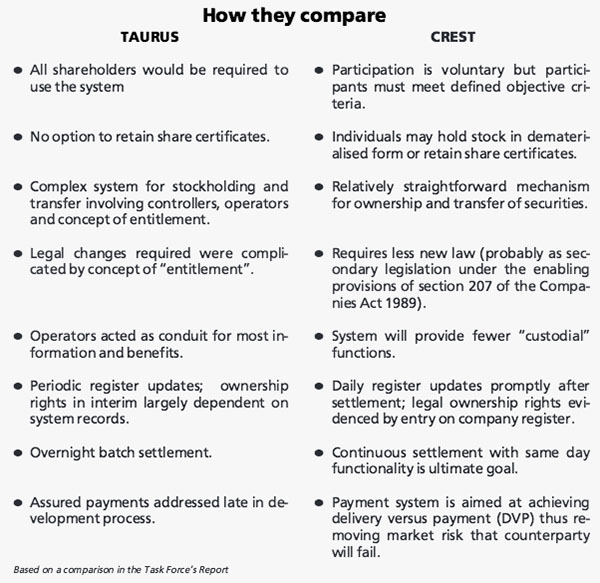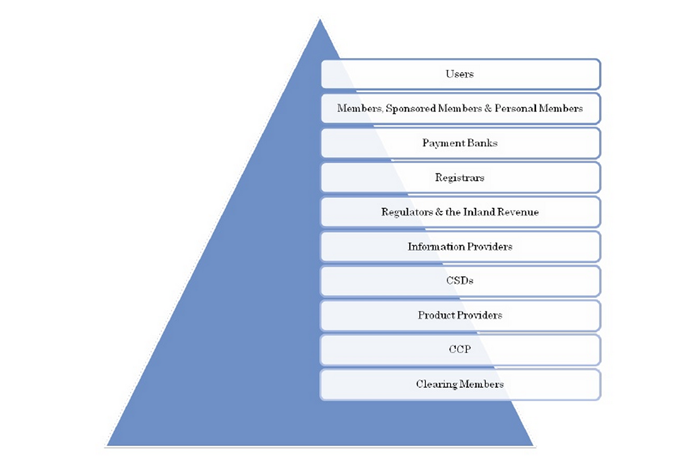It ran to just 13 lines and a little over 100 words, but the list of recommendations on establishing a cost-effective improvement to London’s equity settlement system heralded the start of one of the most crucial projects in the City’s history. CREST – as the new settlement system was christened – celebrates its 20th anniversary this year and is still hailed as one of the most successful systems ever undertaken in financial markets.
The concept is simple: CREST is the Central Securities Depository (CSD) that provides processing and settlement for a wide range of British and overseas equities and gilts. It was designed to replace the outdated and creaking Talisman system, which was struggling to handle even the relatively small trading volumes going through the market at that time. But the stakes were high: the London Stock Exchange had just spent £75m – with the cost to the market as much as five times that – and the best part of a decade developing
Taurus, which was supposed to shift equity trading from paper to computer. Its failure has become a management case study, blamed on everything from poor strategic management to excessive complexity. But one thing was clear: London could not afford another disaster.
Paradoxically, however, that became an advantage. Scott Dobbie FCSI(Hon), who took over as Chairman of CREST following the retirement of the inaugural chair – the late Pen Kent, a director of the Bank of England – said: “The thing that made it easier for CREST was the fact that Taurus had failed.”
Not enough creditIt is the most common reason cited by the experts interviewed for a
new research project analysing CREST’s success, which is being carried out by three academics – Dr Hermann Rapp from Anglia Ruskin University in Cambridge and Chelmsford, Dr Marta Gasparin from the University of Leicester, and Dr Cristiana Parisi from Copenhagen Business School – and led by City think tank B.I.S.S Research. Gary Wright, CEO of B.I.S.S, says: “There is some truth in that; if you have had a major disaster, you have to make the next one work. But that does not give enough credit to the CREST team and the design of the project.”
“The CREST team ripped up the rule book in so many areas”The researchers asked respondents if they could think of another major infrastructure system that came in below budget, and on time. They could not. Wright pays tribute to the leadership team of Kent and the first CEO of CREST, Iain Saville CBE FCSI(Hon), who was seconded from the Bank of England. “They were one of the best double acts the City had even seen. Pen had a wonderful way of smoothing over any cracks that appeared, while Iain went marching on to get the project done and ensure it did not lose focus on what it was trying to do,” says Wright.
He recalls working on the integration of CREST into the systems of his then employer, City bank Robert Fleming. “We encountered a barrier [to integration of CREST into its own systems] so I phoned Iain and asked if it would be possible to get someone to help next week. He said they would be round in ten minutes.”
 Source: PLC magazine. CREST: Little Taurus
Technological innovation
Source: PLC magazine. CREST: Little Taurus
Technological innovationManagement was not the only factor in its success, however. “It was also about the technology design,” says Wright. As an example, CREST connects to customers via two networks – SWIFT and BT – and, says Wright, competition between the two helped bring costs down. “Users realised that the longer they sat on the fence, the lower the offers became, so the rate was much lower than under Talisman. The CREST team ripped up the rule book in so many areas.”
The key lesson for other such projects is to keep it simple. Dobbie says the aim was to keep complexity to a minimum. While Taurus was offering all sorts of extras, with CREST the philosophy was like buying a basic car rather than a model with all the latest gadgets. “If you wanted to go from A to B, we would provide that; there would be no optional extras. We could supply these later,” he says.
Saville cites the fact that CREST had the “complete support of the public sector”, including from the Bank of England, the Treasury, the Department of Trade and Industry – now the Department for Business, Innovation and Skills – and the regulators. He added that frequent, respectful consultation with users was the key to industry support. “It was on our own terms. Consultation was frequent and rapid,” says Saville. “We wrote to a few companies at the start pointing out that their replies had come after the deadline and thus were not taken into account, just to make the point that we set the rules. We responded to all points made in replies, to say, ‘Yes, we can accommodate your suggestion,’ or, ‘Sorry, that is not practicable because of the following reasons.'”
Learning to copeCREST’s success is also evident in both volume of trades and speed of settlement. When the project started, demutualisations of building societies like Halifax were on the horizon and it was acknowledged that Talisman would never have coped. Today, CREST easily copes with
more than one million gross transactions each day, and now includes foreign securities as well as gilts, although early efforts to include unit trusts came to nothing. With Talisman, settlement could take as long as two weeks; now it is two days – and, indeed, it is often the same day as the trade is agreed.
Initially set up as a member-owned company, CREST was acquired by Euroclear in 2003. “One of the things about CREST initially was that it was always an international system – it dealt in Irish pounds as well as sterling,” says Wright.
Saville adds that the need for CREST to be international was recognised from the outset. “We recognised that it had to be multi-currency, partly because we had to deal with the Irish Stock Exchange. But we also felt that we should bring in foreign securities, so that they would be more readily available than if [investors] had to go into the foreign market directly. They were quite major obstacles.
“We favoured a ‘spaghetti model’, using common data and process standards across all markets so CSDs like CREST could inter-operate to serve their clients’ use of stocks from many European markets.” He notes that this model was overtaken by the European Council for Small Business and Entrepreneurship’s TARGET-2 Securities project, which aims to provide a single settlement infrastructure for eurozone countries’ stocks – but has been adopted by central clearing counterparties (CCPs).
Not standing stillCREST did not stand idle after migration was completed in 1997: it absorbed two other UK security settlement systems, built links to other CSDs, provided the processing for the introduction of the UK’s equity CCP, and introduced foreign stocks via CREST Depository interests. Saville says there were several upgrades of software before he left in 2002, and it is a tribute to the robustness of the design that it is shortly to celebrate its 20th birthday.
CREST participants
 Source: Anurag Singh
Source: Anurag Singh
But technology has developed exponentially in recent years and there may be pressures ahead, not just for CREST but also for other UK trading and information systems. Blockchain technology, for example, which underpins the virtual currency bitcoin, allows users to complete transactions between each other securely and instantaneously, without the need for a middleman. Large investors may, therefore, eventually question why they need CREST as that middleman. It could also threaten the role of the registrar, which holds the details of the beneficial ownership of the securities – and, indeed, the advent of CREST had already prompted a dramatic fall in the numbers of registrars. But Saville is not convinced that distributed ledger technologies such as blockchain will threaten CREST in the near future: “
CREST provides central, trusted real-time services where stocks and cash change ownership within a large group of players many times each day. Replacing it by a distributed network would be a major challenge, in terms of both trust and technology; and it is not obvious what the gain would be.”
Dr Rapp and his team will publish initial findings, in the form of an academic paper and an industry report, in the summer. But due to the wealth of data collected, it is anticipated that other reports and papers focusing on different aspects will continue to be produced over the coming years. Dr Rapp said the research project was undertaken as a celebration of CREST’s 20th anniversary, as there was no significant literature detailing the huge impact it had within financial services. Taurus’ failure, on the other hand, has prompted numerous papers, such as this
one by Helga Drummond of the Institute of Public Administration and Management, University of Liverpool. “There has been a significant interest and support in financial markets for this research,” adds Dr Rapp.
Whatever the research finds, given CREST's clear successes, it is unlikely to challenge the view that it has been, and will continue to be, one of the City’s most successful projects.